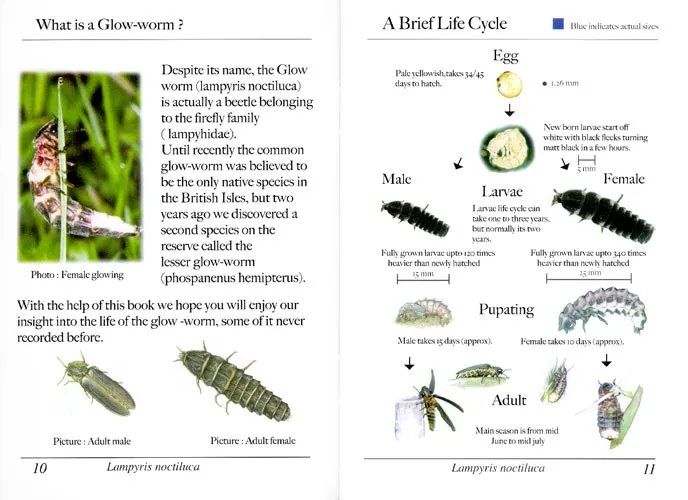
When we talk about glowworms, we aren’t just referring to one specific bug. The name applies to several species, but the most famous is *Lampyris noctiluca*, commonly found in Europe. Their life cycle, much like a story, is made up of several chapters, each involving dramatic changes and quirky behaviors. So, grab a cup of coffee, and let’s dive into the enchanting world of glowworms!
The Egg Stage: Beginning Life in Darkness
Glowworms start their lives as tiny eggs. After mating, female glowworms lay their eggs in small clusters on the ground, typically near the damp areas where their larvae will eventually thrive. This setting is crucial because these young creatures will need a moist environment to survive. Think of it like planting seeds in a garden; the right conditions are essential for growth.
These eggs are remarkably small, about 1-2 millimeters in size. Depending on the species and environmental conditions, the eggs will hatch in about two to three weeks. When they finally break free, the larvae emerge and prepare to embark on the next stage of their life journey.
Larval Stage: The Glow and the Hunt
Once they hatch, glowworm larvae are ready to eat and grow. This stage is quite fascinating because it’s when they start to show off their bioluminescent abilities. But why do they glow? The larvae produce light to attract prey, mainly small insects, like flies. It’s a bit like turning on a neon sign to draw in dinner!
As they glow, the larvae weave silk threads that dangle like fishing lines in the dark. When an unsuspecting insect flies into these sticky traps, the glowworm can pull it up for a meal. This time of the larvae’s life can last anywhere from five to eleven months, depending on the species and environmental factors.
During this stage, you might notice some unique behavioral patterns. For one, glowworm larvae are primarily active at night, making the darkness their ally. They retreat into their silk-lined burrows during the day, waiting for nightfall when they can hunt.
Pupal Stage: The Transformation
Once the glowworm larvae have grown enough, they enter the pupal stage, a time of significant transformation. This stage is when the magic really happens. The larvae stop eating and find a safe place to pupate, often within their silk retreats.
The pupation lasts about two to three weeks, where the glowworm undergoes profound changes from a larva to a mature glowworm. Imagine a caterpillar enveloped in a cocoon, silently transforming into a butterfly. While they might not have a pretty chrysalis, glowworms are certainly hard at work during this phase.
As the pupal stage progresses, their bodies are being restructured. Although they will not eat during this time, they rely on the energy stored from their larval phase. If you were to peek inside—hypothetically, of course—you’d find that everything is gearing up for a grand reveal.
Adult Stage: The Quest for Love
After weeks of anticipation, the adult glowworms finally emerge. This stage is short-lived, lasting only about two months. Adult glowworms look quite different from their larval selves; they develop wings and generally have a more streamlined body. However, unlike many insects, adult glowworms do not eat. Instead, they focus solely on mating.
The adult glowworms are often seen glowing bright to attract mates. Their bioluminescence plays a crucial role in the courtship ritual. Males use their light to signal females, who will respond with their own glow. It’s like a flashing dance in the dark, where both parties are looking for the perfect match!
Once mating occurs, the cycle begins anew as females lay eggs, completing the life cycle of the glowworm. This phase may be short, but it leaves a lasting impression, reminding us of the beauty and transience of life.
Significance of Glowworms in Their Ecosystem
Glowworms are more than just glowing insects; they play important roles in their ecosystems. They help control insect populations by preying on smaller bugs, helping maintain a balance in their habitat. Plus, they are indicators of a healthy environment. High populations of glowworms suggest clean air and water, which is crucial for the thriving ecosystems we depend on.
In many areas, glowworms also attract tourists and nature enthusiasts, offering opportunities for eco-tourism. Places like caves in New Zealand are famous for their stunning displays of glowworms, drawing visitors from around the world. So, they serve a dual purpose—keeping our environment in check while enchanting us with their light.
Conservation Efforts: Protecting Glowworms
Despite their charm and ecological importance, glowworms face threats from habitat destruction, pollution, and climate change. Their specific habitat requirements mean that changes in land use can have significant impacts on their populations. Conservation efforts are essential to ensure that future generations can enjoy the sight of these beautiful insects.
Community awareness and education play a significant role in protecting glowworms. Many organizations work to promote conservation practices, urging people to preserve their natural habitats by reducing pollution and responsible land management. By fostering a connection with nature, we can inspire action and protect these enchanting creatures.
The Final Glow: Understanding the Journey
The life cycle of the glowworm is a remarkable journey of transformation, from tiny eggs to bioluminescent adults. Each stage is filled with unique behaviors and adaptations that highlight the beauty of nature’s design. By understanding their life cycle, we gain insight into the delicate balance of ecosystems and the importance of conservation.
So, the next time you spot a glowworm flickering in the night, you’ll appreciate the incredible story behind that little light. It’s not just an insect; it’s a symbol of resilience, transformation, and the interconnectedness of life on our planet. Let’s cherish and protect these amazing creatures for generations to come!

